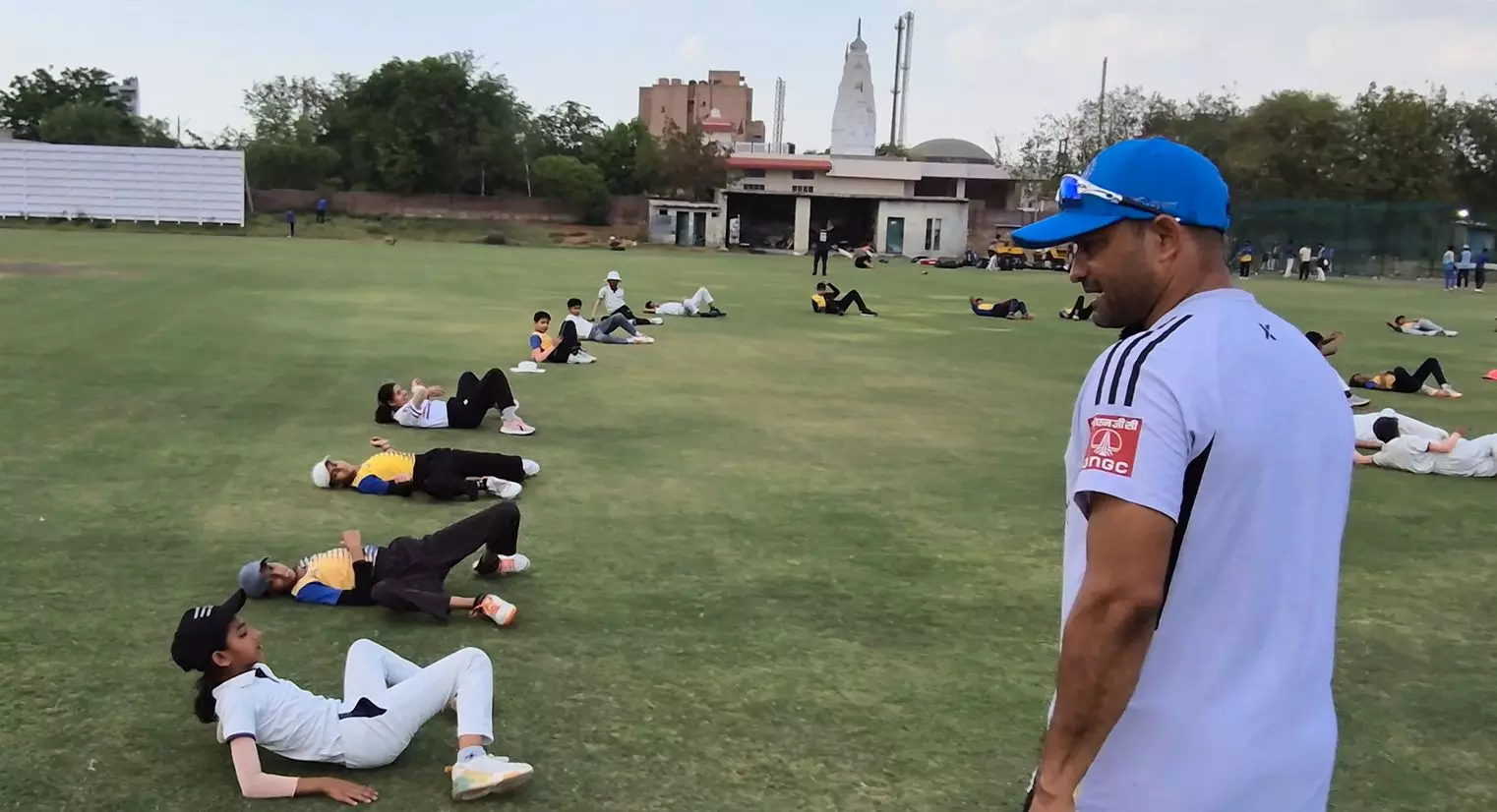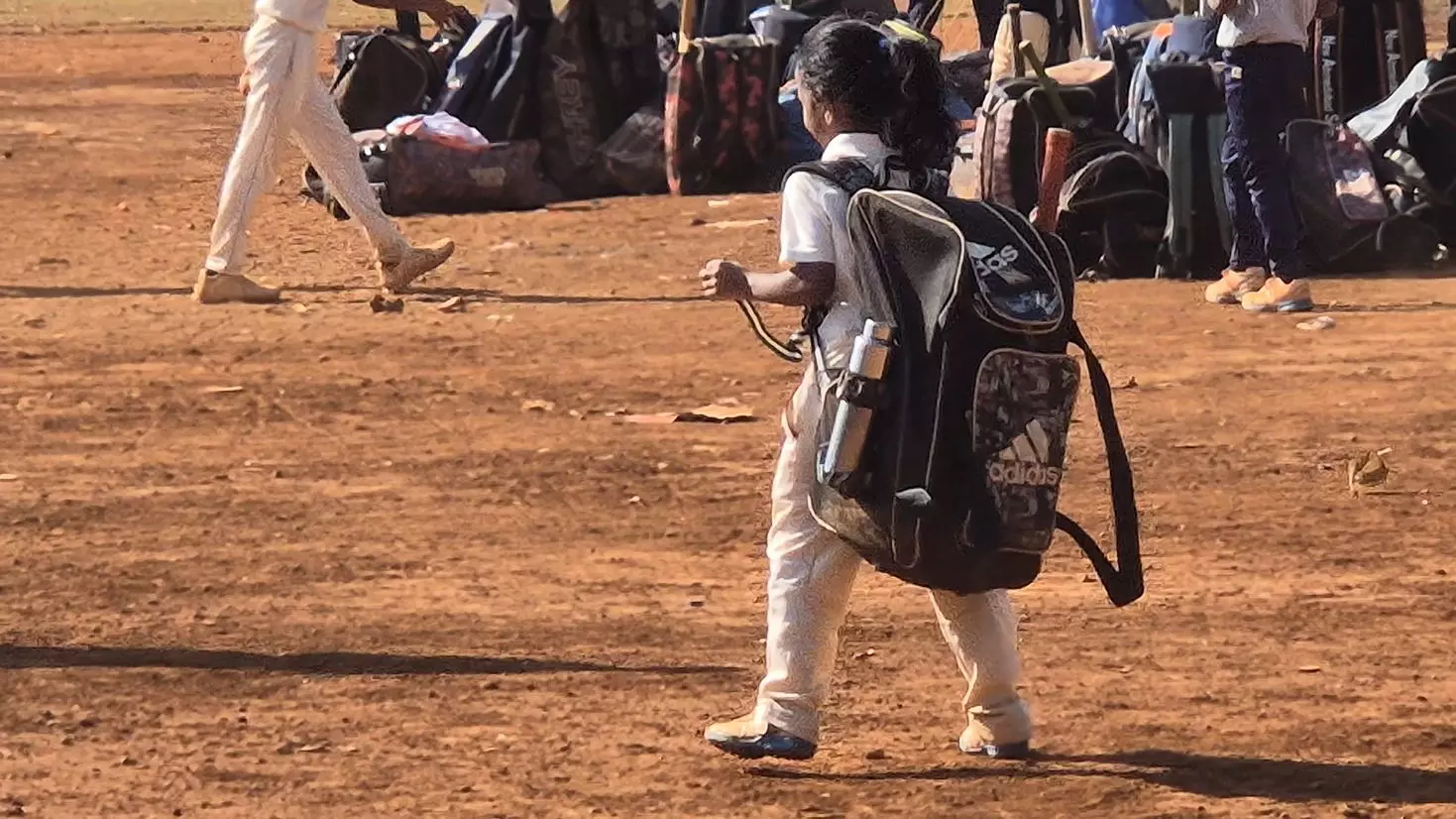
- Home
- India
- World
- Premium
- THE FEDERAL SPECIAL
- Analysis
- States
- Perspective
- Videos
- Sports
- Education
- Entertainment
- Elections
- Features
- Health
- Business
- Series
- In memoriam: Sheikh Mujibur Rahman
- Bishnoi's Men
- NEET TANGLE
- Economy Series
- Earth Day
- Kashmir’s Frozen Turbulence
- India@75
- The legend of Ramjanmabhoomi
- Liberalisation@30
- How to tame a dragon
- Celebrating biodiversity
- Farm Matters
- 50 days of solitude
- Bringing Migrants Home
- Budget 2020
- Jharkhand Votes
- The Federal Investigates
- The Federal Impact
- Vanishing Sand
- Gandhi @ 150
- Andhra Today
- Field report
- Operation Gulmarg
- Pandemic @1 Mn in India
- The Federal Year-End
- The Zero Year
- Science
- Brand studio
- Newsletter
- Elections 2024
- Events
Mumbai to small-town nets, how World Cup win is redrawing the map of women’s cricket in India
Across India’s cricket academies, the number of girls training in the game has grown significantly in recent years. This month's ICC Women’s ODI World Cup victory has set off another wave of enthusiasm, but sustaining it will need infrastructural improvements, say coaches.

In the afternoon sun at Shivaji Park, Mumbai, nine-year-old Kiara (identified by first name only ) pads up for practice. Her father, who travels with her every day for the practice sessions from their residence in the city’s Mahim area, stands quietly by the boundary rope, watching her run up for her first delivery. This is the same ground where coach Ramakant Achrekar once trained...
In the afternoon sun at Shivaji Park, Mumbai, nine-year-old Kiara (identified by first name only ) pads up for practice. Her father, who travels with her every day for the practice sessions from their residence in the city’s Mahim area, stands quietly by the boundary rope, watching her run up for her first delivery. This is the same ground where coach Ramakant Achrekar once trained Sachin Tendulkar and Vinod Kambli. Over the years, amid the familiar chatter of nets and cricket balls, girls in ponytails, some as young as five, have come to carry their kits alongside the boys.
Kiara, a girl of few words but bright eyes, says she loves cricket “to infinity”. Her favourite male cricketer is Virat Kohli; when it comes to women’s cricket, she answered without hesitation, “Smriti Mandhana” — vice captain of the Indian women’s national cricket team which won the World Cup earlier this month. Asked about her dream, Kiara smiled shyly, “I want to replace her [in the women’s cricket team] one day.” Her coach says she has the temperament and skill to make it. “She’s very focused for her age,” he added.
When Indian women’s cricket captain Harmanpreet Kaur lifted the ICC Women’s ODI World Cup at the DY Patil Stadium in Navi Mumbai on November 2, with the home team defeating South Africa in the finals, it wasn’t just the trophy that gleamed under the fireworks. Across sports academies and dusty grounds, something else was set alight. It was belief.
“It was a watershed moment in Indian women’s cricket,” reflected Amol Muzumdar, head coach of the Indian women’s team.
According to the coaches at Shivaji Park, there’s been a clear uptick in enrolment since. “We’ve had more enquiries from parents of young girls than in any month before,” said one coach. “Many of them watched the match as a family and came here the next day.”
While the training remains integrated, boys and girls sharing nets and practice matches, the ratio still reflects the gap. “Roughly, it’s five boys for every girl,” admitted another coach. “But if this win changes mindsets, we could see that ratio narrow. The real test will be whether parents keep supporting these girls after the initial excitement fades.”
But perhaps the most telling changes are happening not in Mumbai or Delhi, where there is already better exposure to opportunities, but in smaller centres, places where visibility has always lagged behind aspiration.
In Jaipur, on a sun-baked afternoon at the Jaipuria Cricket Academy, a group of young girls in oversized helmets wait their turn at the nets. Among them is Mehak Uppadhaya, 13, who joined the academy right after India’s World Cup win. Her mother, Shashi Uppadhaya, watches from the shade, still surprised by her daughter’s resolve. “Earlier we thought cricket was too rough for girls,” she said. “But seeing Harmanpreet lift that trophy changed something at home.”
Mehak remembers being teased for choosing cricket and how a neighbour once told her father to make her focus on studies instead of playing on the street.
“Before, people laughed when I said I wanted to be a cricketer,” she said. “After the final, that same uncle just said, ‘practice harder’,”.
Also read: Despite laws, why inheriting parental property remains a challenge for women
Former Rajasthan Ranji captain and national coach of the Indian cricket team for the physically differently abled Rohit Jhalani, watches the new faces walking into the Jaipuria Cricket Academy. “We’ve already had 20 to 30 new girls join since the World Cup win,” he said. “Parents are bringing them with a new sense of purpose. The game suddenly feels like a real option.”
Another voice from Jaipur, Vinod Mathur, ex-Rajasthan Ranji captain and now coach at Neerja Modi Academy, echoes this shift in attitude. “Earlier, parents would bring their daughters just for summer camps,” he says. “Now they want regular slots, professional training, and match exposure. The skill level may still be raw, but the intent is strong and that’s the best thing a coach can ask for.”
He notes that the win has done something that no policy could: it has changed conversations at home. “A few years ago, parents hesitated. They worried about marriage, studies, and safety. Now they’re saying, ‘If Harmanpreet and Smriti can do it, why not my daughter?’ That’s a social transformation.”

Coach Rohit Jhalani at the Jaipuria Cricket Academy. Photo by Siddhaarth Mahan
Across India’s cricketing academies, the share of girls has grown significantly in recent years, particularly since the launch of the Women’s Premier League in 2023, says Jhalani. Yet the growth remains uneven, concentrated in metros and state capitals. For every bustling centre like Mumbai or Delhi, there are dozens of small towns where facilities, coaching, and exposure remain limited, say experts.
Now, the World Cup win has triggered another wave of enthusiasm among young girls and their parents. Nationwide data is still catching up, but early indicators are striking. According to local journalists, academies in Kolkata, Bengaluru, and Rourkela have reported a 30–40 per cent rise in enquiries from girls in the two weeks since India made it to the the World Cup final, defeating Australia in semis.
For Jhalani, however, the enthusiasm must now meet infrastructure. “At the top, the system works well but for women’s cricket to truly flourish, we need stronger grassroots competition,” he said. “We need tournaments at school, district, and state levels. We need more qualified female coaches, better facilities, and most importantly, awareness. The BCCI must push the game from the ground up.”
The School Games Federation of India (SGFI) runs girls’ cricket championships and several state boards have introduced district and inter-university tournaments. But consistent calendars, scouting, and investment are still patchy. As one Rajasthan coach puts it, “We can’t find the next Smriti Mandhana if we never get to see her play.”
Also read: How two suicides in UAE uncover the plight of Kerala’s dependent migrant women
Infrastructure remains the single biggest hurdle. Dedicated turf wickets, quality nets and full-time women’s coaches are still rare outside the main cities. Safety is another barrier, especially for girls who train late evenings or travel long distances. “We’ve seen girls quit simply because the logistics were too hard,” rued Jhalani. “That shouldn’t happen to talent.”
He points to small but vital things. Separate changing rooms, washrooms and evening transport safety, that make the difference between participation and dropout. “We have those at our academy,” he added. “But many others don’t. Unless we make these standard, girls will keep leaving halfway.”

A young girl with her cricket kit. Photo by Siddhaarth Mahan
Back at Shivaji Park, Kiara’s father waits patiently as she finishes her drills. He works in a private firm nearby but says this daily routine is non-negotiable. “If she has a dream, I must give her the chance,” he said simply. “Watching the women lift that trophy, I knew we’re entering a new time. My daughter now sees herself in them.”
For coaches like Jhalani, that’s the biggest victory. “Any sport grows when it has heroes,” he said. “Now, our girls know their heroes by name, Smriti, Harman, Jemimah [Roderigues], Shafali [Verma]. That’s how a movement begins.”
Also read: How women from Telangana’s Irkode village built a global meat pickle brand
The World Cup win has set off a wave but sustaining it will need structure. As Muzumdar noted, “Talent is not the issue in India. Opportunity is.” That means not just celebrating the champions, but investing in the pipeline: scholarships for girls from smaller towns, certified women coaches, district leagues, and access to safe, gender-sensitive facilities.
If those systems are built, the day is not far when girls like Kiara will not just dream of replacing their idols, they’ll stand shoulder to shoulder with them.
As the sun dips over Shivaji Park, the little girl takes one last swing, the ball connecting sweetly. Her coach claps, her father smiles. Somewhere between the heat and the hope, Indian cricket’s next revolution is already taking shape.
